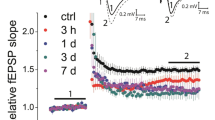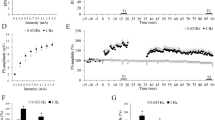Summary
The actions of three clinically effective antidepressant drugs with different pharmacological profiles were investigated in the CAI area of rat hippocampal slices. Imipramine and (+) or (−)-oxaprotiline had negligible effects on population spikes evoked by stratum radiatum stimulation, but reduced postsynaptic excitability in low Ca high Mg medium after an exposure of more than 15 min. Imipramine and (+)-oxaprotiline at 10 μmol/l enhanced long-term potentiation (LTP) when a lower stimulation strength was applied while (+)-oxaprotiline reduced UP when a higher stimulus amplitude was used to evoke population spikes. (−)-oxaprotiline (levoprotiline) had a similar effect which was, however, not significant in either stimulation paradigm at the P<0.05 level. Imipramine actions were also studied on epileptiform discharges in Mg2+-free medium: a facilitation-inhibition sequence with a slow time course was seen with 50 μmol/l but no effect with 10 μmol/l. An involvement of N-methyl-D-aspartate (NMDA)-receptors in acute actions of antidepressants is unlikely but long-term potentiation in the hippocampus is modulated by these drugs.
Similar content being viewed by others
References
Anwyl R, Rowan MJ (1985) Frequency-dependent block of field potentials in the rat hippocampal slice caused by tricyclic antidepressants. Br J Pharmacol 86:201–208
Bliss TVP, Lynch MA (1988) Long-term potentiation of synaptic transmission in the hippocampus: Properties and mechanisms. In: Deadwyler SA, Landfield PW (eds) Long-term potentiation: From biophysics to behavior. Alan R Liss, pp 3–72
Collingridge GL, Kehl SJ, McLennan H (1983) Excitatory amino acids in synaptic transmission in the Schaffer collateral-commissural pathway of the rat hippocampus. J Physiol 334:33–46
Delini-Stula A, Hauser K, Baumann P, Olpe HR, Waldmeier P, Storni A (1982) Stereospecificity of behavioural and biochemical responses to oxaprotiline - a new antidepressant. In: Costa E, Racagni G (eds) Typical and atypical antidepressants. Raven Press, New York, pp 265–276
Dunwiddie TV, Robertson NL, Worth T (1982) Modulation of long-term potentiation: Effects of adrenergic and neuroleptic drugs. Pharmacol Biochem Behav 17:1257–1264
Errington ML, Lynch MA, Bliss TVP (1987) Long-term potentiation in the dentate gyrus: Induction and increased glutamate release are blocked by D(−)aminophosphonovalerate. Neuroscience 20: 279–284
Haas HL, Jefferys JGR (1984) Low-calcium field burst discharges of CA1 pyramidal neurones in rat hippocampal slices. J Physiol 354:185–201
Harley CW Milway JS (1986) Glutamate ejection in the locus coeruleus enhances the perforant path-evoked population spike in the dentate gyrus. Exp Brain Res 63:143–150
Harris EW, Cotman CW (1986) Long-term potentiation of guinea pig mossy fiber responses is not blocked by N-methyl-D-aspartate antagonists. Neurosci Lett 70:132–137
Kostopoulos G, Psarropoulou C, Haas HL (1988) Membrane properties, responses to amines and to tetanic stimulation of hippocampal neurons in the genetically epileptic mutant mouse tottering. Exp Brain Res 72:45–50
Krijzer F, Snelder M, Bradford D (1984) Comparison of the (pro)convulsive properties of fluvoxamine and clovoxamine with eight other antidepressants in an animal model. Neuropsychobiology 12: 249–254
Luchins DJ, Oliver AP, Wyatt RJ (1984) Seizures with antidepressants: an in vitro technique to assess relative risk. Epilepsia 25:25–32
Mishra R, Gillespie DD, Lovell RA, Robson RD, Sulser F (1982) Oxaprotiline: induction of central noradrenergic subsensitivity by its (+)-enantiomer. Life Sci 30:1747–1755
Morris RGM, Anderson E, Lynch GS, Baudry M (1986) Selective impairment of learning and blockade of long-term potentiation by an N-methyl-D-aspartate receptor antagonist, AP5. Nature 319: 774–776
Okuyama S, Aihara H (1989) Effect of minaprine on electrical activity of the rat hippocampus in vivo. Naunyn-Schmiedeberg's Arch Pharmacol 340:1–5
Psarropoulou C, Haas HL (1989) Action of anticonvulsants on hippocampal slices in Mg-free medium. Naunyn-Schmiedeberg's Arch Pharmacol 339:613–616
Reynolds IJ, Miller RJ (1988) Tricyclic antidepressants block N-methyl-D-aspartate receptors: similarities to the action of zinc. Br J Pharmacol 95:95–102
Richelson E, Nelson A (1984) Antagonism by antidepressants of neurotransmitter receptors of normal human brain in vitro. J Pharmacol Exp Ther 230:94–102
Sernagor E, Kuhn D, Vyklicky L, Mayer ML (1989) Open channel block of NMDA receptor responses evoked by tricyclic antidepressants. Neurons 2:1221–1227
Shors TJ, Seib TB, Levine S, Thompson RF (1989) Inescapable versus escapable shock modulates long-term potentiation in the rat hippocampus. Science 244:224–226
Sills MA, Loo PS (1989) Tricyclic antidepressants and dextromorphan bind with higher affinity to the phencyclidine receptor in the absence of magnesium and L-glutamate. Mol Pharmacol 36 160–165
Stanton PK, Sarvey JM (1985) Depletion of norepinephrine, but not serotonin, reduces long-term potentiation in the dentate gyrus of hippocampal slices. J Neurosci 5:2169–2176
Sugimura M, Ishihara K, Katsuki H, Satoh M (1989) Indeloxazine augments long-term potentiation in the mossy fiber-CA3 system of guinea pig hippocampal slices. J Pharmacobio-Dyn 12:771–774
Waldmeier PC, Baumann PA, Hauser K, Maitre L, Storni A (1982) Oxaprotiline, a noradrenaline-uptake inhibitor with an active and an inactive enantiomer. Biochem Pharmacol 31:2169–2176
Wigström W, Gustafsson B (1983) Facilitated induction of hippocampal long-lasting potentiation during blockade of inhibition. Nature 301:603–604
Author information
Authors and Affiliations
Additional information
Send offprint requests to H.L. Haas, Düsseldorf
Rights and permissions
About this article
Cite this article
Birnstiel, S., Haas, H.L. Acute effects of antidepressant drugs on long-term potentiation (LTP) in rat hippocampal slices. Naunyn-Schmiedeberg's Arch Pharmacol 344, 79–83 (1991). https://doi.org/10.1007/BF00167385
Received:
Accepted:
Issue Date:
DOI: https://doi.org/10.1007/BF00167385




